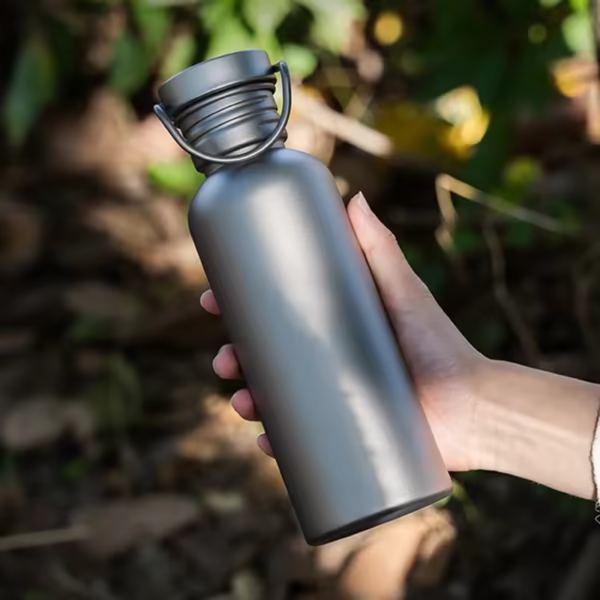Understanding Material Safety in Everyday Hydration
For outdoor adventurers, medical professionals, and health-conscious consumers alike, the choice of water bottle isn’t just about convenience — it’s about long-term health. When exposed to high heat, acidic drinks, or prolonged reuse, some materials can leach harmful chemicals or degrade in ways that compromise safety.
We have chosen titanium, an environmentally friendly, healthy, light and strong material, since we started producing water bottles. Our more than ten years of production experience have witnessed the increasing popularity of titanium as a safe and long-lasting hydration material. But how does it compare to stainless steel, glass or BPA-free plastic?
Let’s take a deep look into the healthiest water bottle materials — and why titanium consistently ranks at the top.
Comparing the Safest Water Bottle Materials
| Malzeme | Health Profile | Heat Resistance | Durability | Taste Neutrality | Recyclability |
|---|---|---|---|---|---|
| Titanyum | Biocompatible, non-toxic, no leaching | Excellent | Excellent | Excellent | 100% recyclable |
| Paslanmaz çelik | Generally safe, may leach nickel/chromium | Very Good | Excellent | Good | Recyclable |
| Glass | Chemically inert, very safe | Ilıman | Fragile | Excellent | 100% recyclable |
| BPA-Free Plastic | Safer than older plastics but may still degrade | Poor | Ilıman | Variable | Partially |
| Aluminum (Lined) | Requires plastic liner (may degrade over time) | Poor | Good | Variable | Low |
Why Titanium Is Considered the Healthiest Choice
1. Non-Toxic and Biocompatible
Titanium is classified as a medically safe material — it’s widely used in surgical implants and dental devices for a reason. Unlike plastics or even some stainless steel grades, it does not release any ions or toxins into water, even under prolonged use or heat exposure.
2. Heat-Resistant and Flame-Safe
Unlike plastics and even glass, titanium bottles can be placed directly over an open flame to boil water. This makes them ideal for backcountry travel, emergency preparedness, or military operations where safe water access is critical.
3. No Metallic Taste or Chemical Leaching
Pure titanium does not react with acidic or alkaline liquids. Users consistently report that water tastes cleaner and “neutral” compared to stainless steel or plastic bottles.
Case in point: A Japanese ultralight hiking gear brand we supplied with Grade 1 titanium reported a zero taste-change rating after 200 boiling tests in saltwater and acidic tea conditions.
4. Lightweight and Long-Lasting
Despite its strength, titanium is 45% lighter than steel and resistant to corrosion, dents, and biological buildup. A well-made titanium water bottle can last for over a decade with minimal care.
Technical Overview: Why Titanium Outperforms
| Mülk | Titanyum | 316L Stainless Steel | Borosilicate Glass | BPA-Free Plastic |
|---|---|---|---|---|
| Melting Point | 1,668°C | ~1,400°C | ~820°C | <200°C |
| Density | 4.5 g/cm³ | 8.0 g/cm³ | 2.23 g/cm³ | ~1.0 g/cm³ |
| Chemical Reactivity | Inert | May react w/ acids | Inert | Degrades w/ UV |
| Toxicity Risk | None (medical grade) | Possible Ni/Cr leach | None | Potential microplastics |
| FDA / Medical Use Grade | Yes (Grades 1–2) | Some grades only | No | No |
FAQ: Health & Safety of Bottle Materials
Q1: Is titanium safe to drink from daily?
Yes. Pure titanium (Grades 1 and 2) is non-toxic, biocompatible, and FDA-compliant. It’s used in medical implants and is safe even when heated.
Q2: Can stainless steel water bottles be harmful?
While high-grade stainless steel (like 316L) is generally safe, cheaper grades may leach nickel or chromium, especially with acidic liquids like citrus or coffee.
Q3: What about glass bottles? Are they safer?
Glass is chemically stable, but its fragility limits use in outdoor or travel situations. Breakage risks make it less ideal for children or hikers.
Q4: Is BPA-free plastic a good alternative?
“BPA-free” doesn’t guarantee full safety — some plastics still release microplastics or degrade under UV light. It also can’t withstand high temperatures.
Q5: Why don’t more brands use titanium?
Titanium is harder to process and more expensive than plastic or steel. But with rising health and environmental concerns, it’s gaining traction in premium markets.
Conclusion: Health Starts with Materials
If you’re looking for the healthiest, most versatile, and environmentally responsible material for your water bottle, titanium stands unmatched. Whether you’re a mountaineer, a minimalist, or simply someone who values purity in what you drink, titanium offers safety without compromise.
% 100 saf titanyum su şişesi
-
% 100 saf derece 1 titanyumdan yapılmıştır
-
Ultra hafif, dayanıklı ve korozyona dayanıklı
-
Hassas titanyum kapaklı sızıntıya dayanıklı conta
-
Ateş veya ocak üzerinde kaynamak için güvenli - kaplama yok, astar yok
-
Plastiksiz, BPA içermeyen ve metalik bir tat yok
-
Yürüyüş, kamp ve seyahat için ideal

